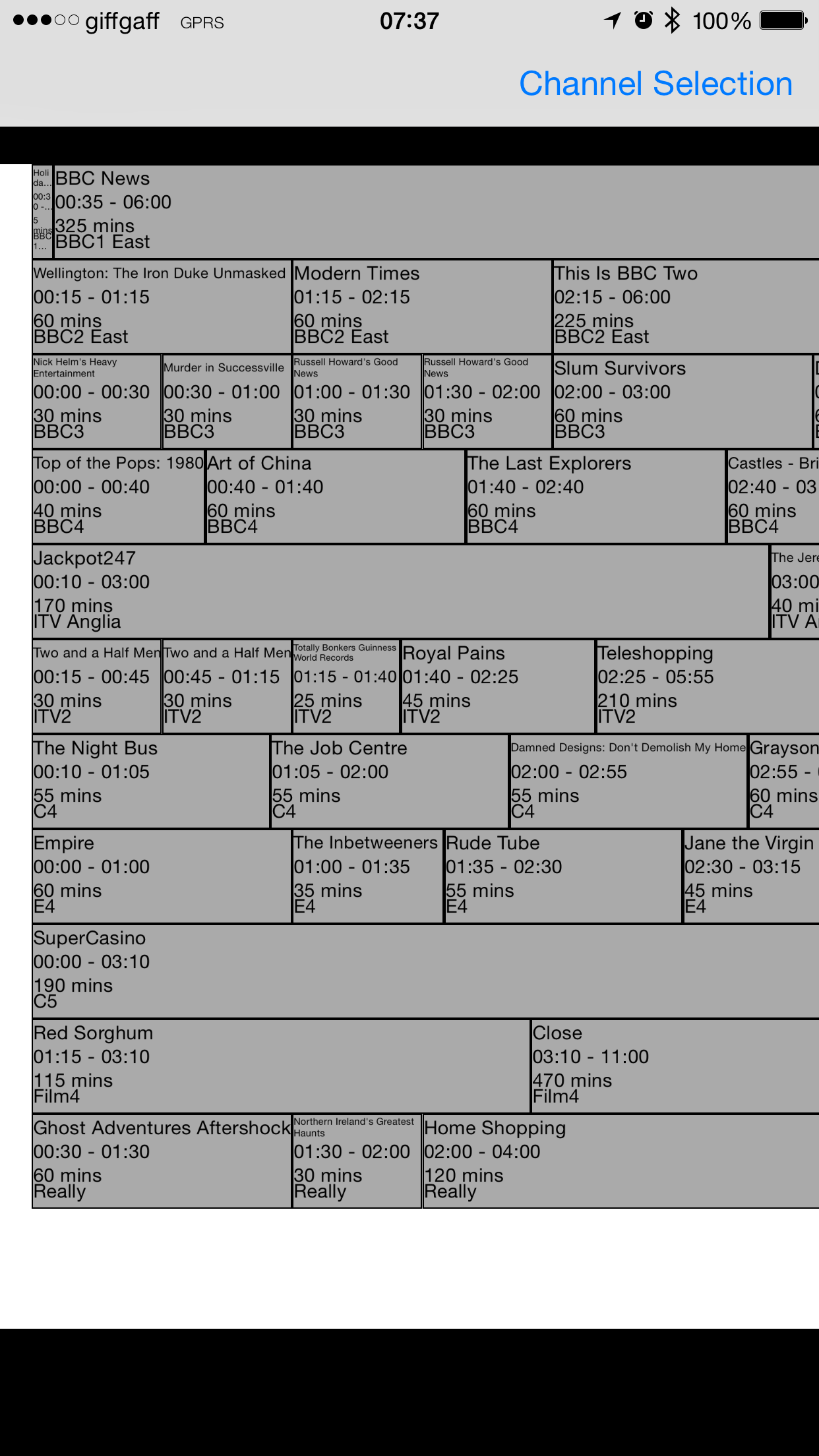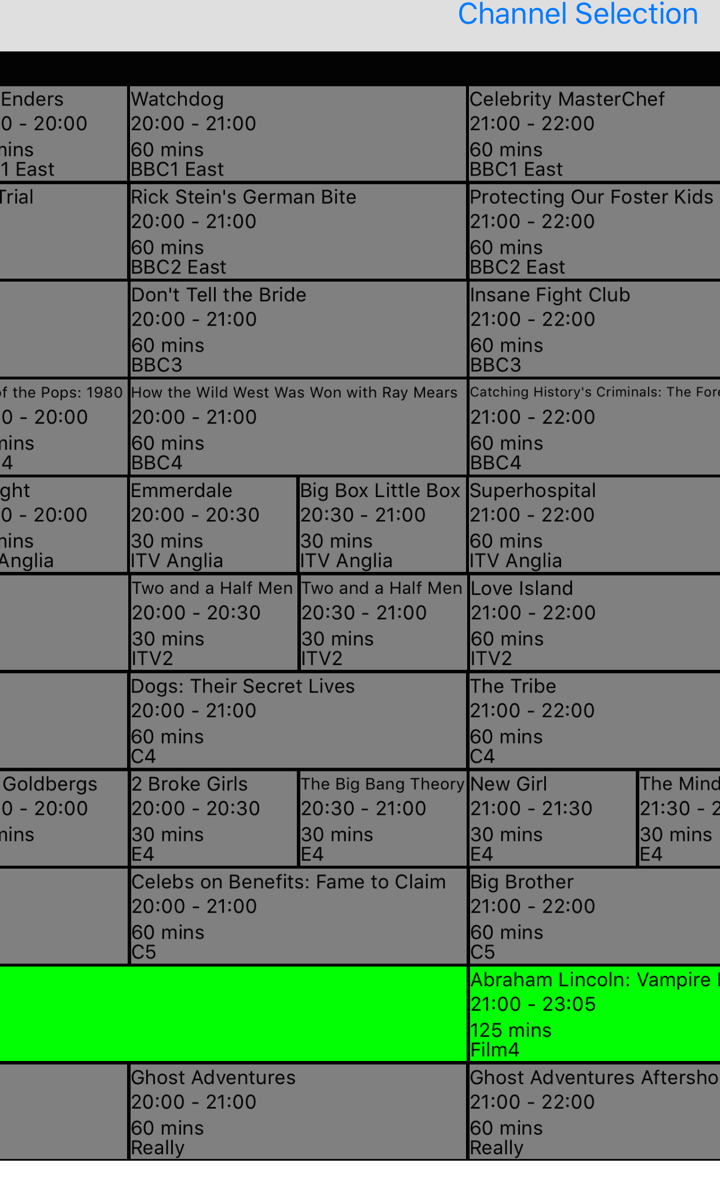A little later than intended, here’s the follow-up to my first posting on building an EPG.
So, having marshalled the data into a structure that can be displayed, on to the guts of this app, which is the main UIView for guide itself. The pre-requisite of that main view is configuring the scrollView: I’m not going to dwell on this too long, as it’s a well documented feature.
For the formatting of the content in that classic programme guide UI, with rows of variable width cells, I initially started with looking at collectionViews, but couldn’t find a way of doing it – or certainly an amenable way. I also briefly looked at customising a tableView, which I could add multiple elements to, but rejected it for the same reason.
I finally settled on a custom implementation, with each programme being represented by its own UIView, with:
- the width: the duration in minutes divided by the number of minutes in the day, then multiplied by the width of the scrollview.
- the height: this is a constant for all the cells, just based on experimenting with the scrollView.
For what it’s worth, my scrollView is 4000, and the row height is 60. [Actually it’s the width of the contentView the scrollView contains, but I’ll refer to the scrollView from here for purposes of readability.]
Before I go on to calculating the [X,Y] coordinates of the top left corner of the subview, I need to recap on how the programme information is written to Core Data and then read back. At some point in the implementation as I envisage it, it will be possible for the user to both download more programme data, as only a couple of weeks worth come down at a time, and also to configure which channels to do the download for. For ease of simplicity of managing the stored data, I decided to write all of the programme data to the same Core Data entity [think database table], and when the user repeats the download, with or without changing the channel configuration, I delete the existing data – a fairly blunt but effective instrument.
When it comes to retrieving the data, which I do on a per-channel basis, I need to search using an NSPredicate:
NSPredicate *predicate = [NSPredicate predicateWithFormat:@"(channel = %@) AND (startDate >= %@) AND (endDate <= %@)", channelName, startDateForSearch, endDateForSearch]; NSFetchRequest *allChannelDataReq = [[NSFetchRequest alloc] init]; [allChannelDataReq setEntity:[NSEntityDescription entityForName:@"Programme" inManagedObjectContext:managedObjectContext]]; [allChannelDataReq setPredicate:predicate]; [allChannelDataReq setIncludesPropertyValues:NO]; NSError *error = nil; tempArrayOfFilteredProgData = [managedObjectContext executeFetchRequest:allChannelDataReq error:&error];
So this block of code is searching for hits on a given channel, startDate and endDate [attributes of the Entity], and loading them into the array. I’ve already noted these are unsorted, so…
NSSortDescriptor *sortByRunningOrderInt = [[NSSortDescriptor alloc] initWithKey:@"progOrderNum" ascending:YES]; NSArray *descriptors = [NSArray arrayWithObject:sortByRunningOrderInt]; NSArray *sortedProgDataForChannel = [channelData sortedArrayUsingDescriptors:descriptors];
…where the progOrderNum is the corresponding attribute in the Entity.
The sortedProgDataForChannel can now be looped through, for each programme:
- (NSMutableDictionary *)drawRect:(float)width startXPosn:(float) topLeftX rowNum:(int)rowNum forColour:(UIColor *)cellColour
{
NSMutableDictionary *viewAndCoords = [[NSMutableDictionary alloc] init];
float topLeftY = rowNum * rowHeight;
float topLeftXForNextView = topLeftX + width;
CGRect rectangle = CGRectMake(topLeftX, topLeftY, width, rowHeight);
UIView *thisProgView = [[UIView alloc] initWithFrame:rectangle];
thisProgView.backgroundColor = cellColour;
thisProgView.layer.borderColor = [UIColor blackColor].CGColor;
thisProgView.layer.borderWidth = 1.0;
[viewAndCoords setObject:thisProgView forKey:@"view"];
[viewAndCoords setObject:[NSNumber numberWithFloat: topLeftXForNextView] forKey:@"newTopLeftCoord"];
return viewAndCoords;
}
The idea here is to calculate the width, as described above, and create the UIView [with a couple of frills like a border], and then return the X co-ordinate for the starting point for the next view. The Y coordinate is a simple calculation: I assign the channels a number, and then multiply that by the height of each cell.
That, in essence is the primary logic for building the ‘wireframe’ for the programmes. I extract the text for a given programme’s title, start and end times, etc, and add those as labels programmatically. Again, these are calculated as offsets from the starting X coordinate and the calculated Y based on channel number.
There are a couple of gotchas, and I had to take a couple of bites at this – which is a polite way of saying I made a couple of idiotic mistakes – and the visual results of which were so bad that I decided to record them for posterity. The first is an example of not reading the documentation. I misremembered the parameters for a UIView as being X+Y for the top left corner, and then X+Y for the bottom right corner. This resulted in the following:
It really is a thing of beauty :).
Next up was dealing with the simple matter of the start of the day. The NSPredicate I use extracts per-channel programme data for start times on a given date. I was then merrily plastering these onto the scrollView with the following results:
Obviously a refinement is required, so first port of call was to make 5am the equivalent of the left edge of the scrollView. I decided that, rather than hardwiring this into the search parameter for the NSPredicate – in case I changed my mind later – I’d do it when looping through the channel data.
So first of all, I see if the start time of the given programme is >= 5am. If not I disregard it. If it is, I then calculate the offset for the X coordinate. This is based on calculating the difference between the start time of the programme and 5am in minutes. I then divide this by the number of minutes in the day and multiply it by the width of the scrollView. There’s an additional offset [which actually applies to all of the programme UIViews] for a channel title list down the left hand side of the scrollView.
-(int) calcPosOfFirstProg:(NSDate *)progStartTime
{
int xPos = 0;
// This start x posn allows for the channel name label
int offSetForChanTitle = 100;
// So: the left edge of the view equates to 5am.
NSDateFormatter *dateFormatter = [[NSDateFormatter alloc] init];
// formatting from just HH:mm didn't work because the progStartTime has a date.
// need to extract today's date from progStartTime and bake it into the viewEdgeTime...
[dateFormatter setDateFormat:@"dd/MM/yyyy"];
NSString *dayDateForDisplayDay = [dateFormatter stringFromDate:progStartTime];
NSString *viewEdgeTimeString = [NSString stringWithFormat:@"%@ 05:00", dayDateForDisplayDay];
[dateFormatter setDateFormat:@"dd/MM/yyyy HH:mm"];
NSDate *viewEdgeTime = [dateFormatter dateFromString:viewEdgeTimeString];
// Time interval gives us the number of seconds:
NSTimeInterval timeDiff = [progStartTime timeIntervalSinceDate:viewEdgeTime];
// All other calculations on positioning have been in minutes so:
float minsBetweenTimes = timeDiff / 60;
NSLog(@"minsBetweenTimes is %f", minsBetweenTimes);
float minutesInDay = 1140;
xPos = ((minsBetweenTimes / minutesInDay) * scrollViewWidth) + offSetForChanTitle;
return xPos;
}
That channel listing is a bit ugly – it’s why I bake the channel name into the progamme summary. What I’d really like to do is have a “floating” listing that the scrollView passes under. I’ve used key value observers a lot in the past, so one approach would be to set a KVO on the delegate that returns the current scroll scale value, and to resize based on the changes in scale. One to come back to…
It would, of course, be necessary to do the same for the right hand of the scrollView, to make sure that for a given cell, there’s enough room to display it. I haven’t gotten round to this yet, so late finishing programmes dangle precariously into space.
Next up I’ll talk about creating the pop-up view for the programme details, including navigating an ARC related memory error, which took me a loooooooong time to figure out!




